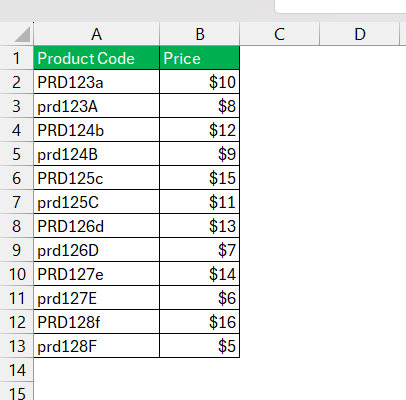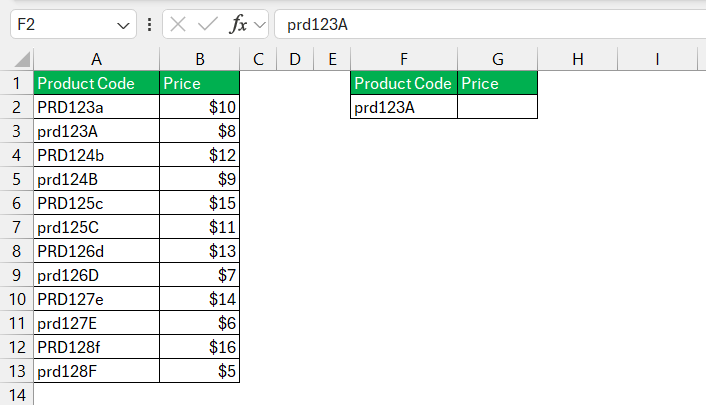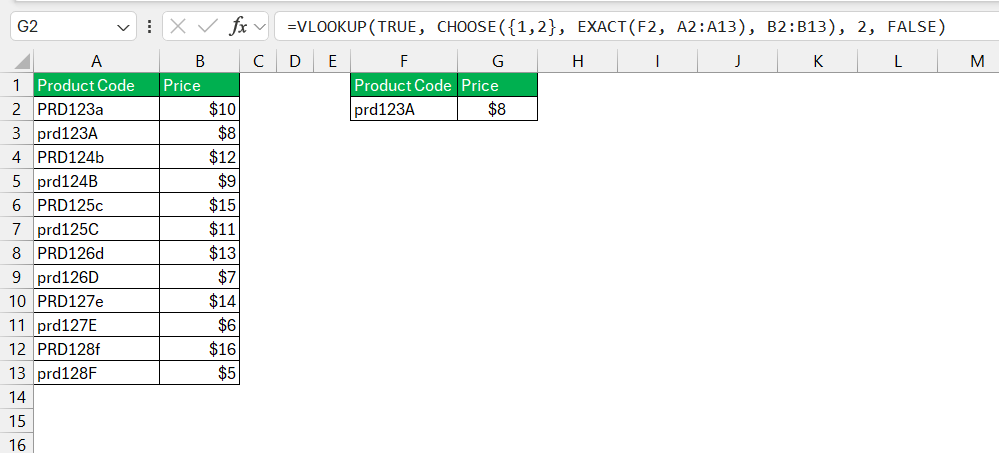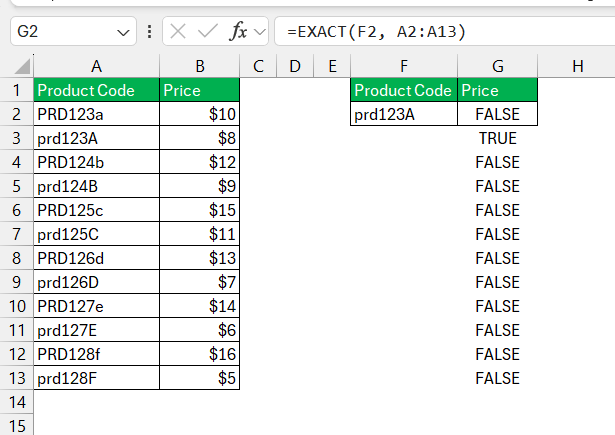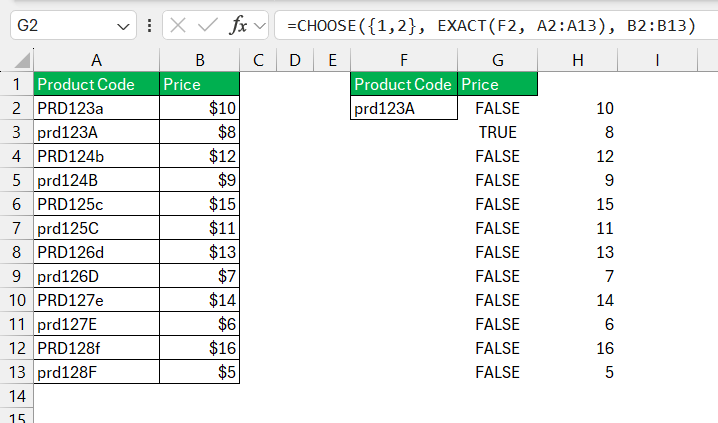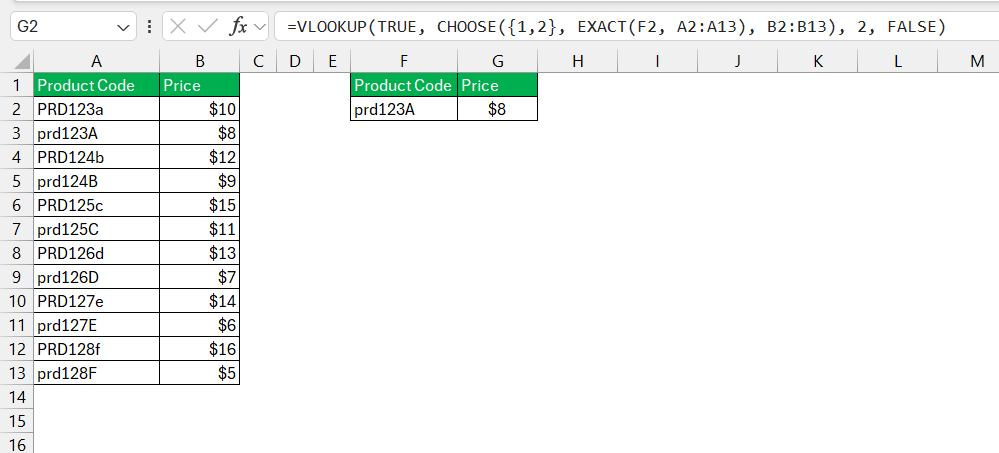Performing a case-sensitive search using VLOOKUP in Excel can be a bit tricky, as the standard VLOOKUP function is not case-sensitive. This article explores techniques and workarounds, including the use of the EXACT function, to achieve case-sensitive lookups, ensuring more accurate and precise data retrieval.
Key Takeaways:
- Standard VLOOKUP in Excel is not case-sensitive, leading to potential inaccuracies when case distinction is crucial.
- Achieving VLOOKUP case sensitive requires combining VLOOKUP with other functions, such as EXACT, within an array formula.
- The CHOOSE and EXACT functions can help create a workaround for case-sensitive VLOOKUP by comparing text strings exactly as entered.
- Common issues include forgetting to enter the array formula with CTRL+SHIFT+ENTER and mixing up exact and approximate match arguments.
- Testing formulas on small datasets and using Excel’s Formula Auditing tools can help ensure accuracy in complex case-sensitive lookups.
Introduction to VLOOKUP’s Case Sensitivity Challenges
The Basics of VLOOKUP
When I dive into the powerful realm of Excel’s VLOOKUxP function, it’s important for me to grasp the basics. VLOOKUP is a handy tool for vertical searches, helping me scour through a defined range to find a specific piece of information and retrieve data from a corresponding column.
Despite its prestige, it does come with an inherent limitation—it’s not case-sensitive. Imagine I’m playing detective with data, but my clues won’t discriminate between ‘clue’ and ‘CLUE.’ That’s where I might find myself a bit stuck with VLOOKUP in its standard form.
Understanding the Importance of Case Sensitivity
Understanding the importance of case sensitivity in Excel can sometimes be the line between accurate data representation and potential errors. When dealing with text data, differentiating between ‘RED’, ‘Red’, and ‘red’ could represent distinct categories, stock-keeping units (SKUs), or even password verifications where case sensitivity becomes crucial for precision.
If I’m handling a dataset where capitalization conveys different meanings or values, it’s essential for me to respond to this distinction. A regular VLOOKUP may overlook these subtleties, merging different items into one mistaken identity. Therefore, mastering case-sensitive VLOOKUP not only improves the quality of my data analysis but also saves me from inaccuracies that could lead to significant misunderstandings or business decisions based on flawed data.
Enhancing VLOOKUP Case Sensitivity
The Limitations of Standard VLOOKUP Functionality
Despite VLOOKUP being one of the most commonly used functions in Excel, its standard setup does not recognize case differences. This means if I’m performing a lookup for “Green”, VLOOKUP will treat “green”, “GREEN”, and “GrEeN” all the same, potentially leading to incorrect data retrieval. This limitation can be particularly challenging when working with data that is sensitive to capitalization due to its significance—usernames, hexadecimal values, or product codes.
Tricks to Achieve VLOOKUP Case Sensitive in Excel
You’re not stuck with VLOOKUP’s case insensitivity as several clever tricks exist to circumvent this. To achieve a case-sensitive lookup, you can creatively use other Excel functions in conjunction with VLOOKUP, such as the EXACT function, which compares two text strings and respects case sensitivity.
Step-by-Step Techniques for Case Sensitive Searches
Let’s say you have a list of product codes and their prices. The product codes are case-sensitive, meaning “A123”, “a123”, and “A123” represent different products. You want to look up the price of a specific product code while respecting the case.
STEP 1: Ensure your data is in columns A and B as shown above.
STEP 2: Enter “prd123A” in cell F2.
STEP 3: In cell G2, enter the formula: =VLOOKUP(TRUE, CHOOSE({1,2}, EXACT(F2, A2:A13), B2:B13), 2, FALSE)
After typing the formula, press CTRL+SHIFT+ENTER.
The formula =VLOOKUP(TRUE, CHOOSE({1,2}, EXACT(F2, A2:A13), B2:B13), 2, FALSE) will return $8 because “prd123A” in A3 matches exactly with F2 (“prd123A”).
Explanation
EXACT Function: EXACT(F2, A2:A13) generates an array of TRUE/FALSE values based on whether each value in A2:A13 matches “prd123A” exactly.
For F2 = "prd123A": [FALSE, TRUE, FALSE, FALSE, FALSE, FALSE, FALSE, FALSE, FALSE, FALSE, FALSE, FALSE].
CHOOSE Function:
CHOOSE({1,2}, EXACT(F2, A2:A13), B2:B13) combines the array of TRUE/FALSE values with the prices, resulting in: {{FALSE, $10},{TRUE, $8},{FALSE, $12},{FALSE, $9},{FALSE, $15},{FALSE, $11},{FALSE, $13},{FALSE, $7},{FALSE, $14},{FALSE, $6},{FALSE, $16},{FALSE, $5}}
VLOOKUP Function:
VLOOKUP(TRUE, ..., 2, FALSE) searches for the first TRUE value in the first column of the array and returns the corresponding value from the second column. It finds TRUE at the second position, corresponding to the value $8.
This approach ensures that your lookup respects case sensitivity, distinguishing between different cases like “PRD123a” and “prd123A”.
Troubleshooting Common Issues
Typical Mistakes When Creating Case Sensitive VLOOKUPs
When creating case-sensitive VLOOKUPs, a few typical mistakes could trip you up. For starters, forgetting that standard VLOOKUPs are case-insensitive can lead to erroneous results right out of the gate. Also, mixing up the exact match (FALSE) and approximate match (TRUE) arguments in VLOOKUP can cause unexpected outcomes.
Another common error is neglecting to use CTRL+SHIFT+ENTER to properly enter array formulas — missing this key step will prevent your formula from functioning as intended. And finally, overlooking the limitations of VLOOKUP, such as it not working with ranges to the left of the lookup column, can stifle its effectiveness.
Ensuring Accuracy in Complex Formulas Involving Case Sensitivity
Ensuring accuracy in complex Excel formulas, especially when tinkering with case sensitivity, involves meticulous attention to detail. To maintain precision, structure your formulas properly by carefully nesting the functions, and double-checking their syntax. Watch out for absolute and relative cell references, ensuring they are used correctly to avoid dragging errors through a series.
Moreover, formulas should always be tested on a small data segment before being applied broadly. Additionally, using Excel’s Formula Auditing tools can help trace errors and evaluate formulas step by step, preventing those perplexing #VALUE! or #N/A errors from creeping in.
FAQs: Expert Answers for Your Case Sensitive Queries
Is VLOOKUP case sensitive in Excel?
No, VLOOKUP function is not case-sensitive in Excel. It treats uppercase and lowercase characters as the same. For example, VLOOKUP will match ‘apple’ with ‘Apple’ and ‘APPLE’. If case sensitivity is a requirement for your data search, you will need to modify your approach or use a different formula to achieve accuracy.
How Can I Make My VLOOKUP Searches Case Sensitive by Default?
There isn’t a direct setting to make VLOOKUP case sensitive by default. However, you can attain case sensitivity by combining VLOOKUP with other functions, such as the EXACT function within an array formula. This workaround can be established as your standard template if case sensitivity is consistently required in your Excel tasks.
Why is My Case Sensitive VLOOKUP Not Returning Correct Results?
Your case-sensitive VLOOKUP might not return correct results if there’s a mistake in the function’s structure or syntax. Ensure that the EXACT function is used correctly within an array formula, and confirm that you’ve entered the formula as an array (using CTRL+SHIFT+ENTER). Also, double-check that your lookup value and the range being searched are both consistent in case usage.
How to check case-sensitive in Excel?
In Excel, to check for case sensitivity, you can use the EXACT function, which compares two text strings and returns TRUE if they are exactly the same, including case, or FALSE otherwise. It’s a straightforward way to test if two pieces of text match in every detail, including their letter cases.
How do I remove case sensitivity in Excel?
To treat all data in Excel without case sensitivity, simply employ standard functions like VLOOKUP, MATCH, or FIND, as they do not differentiate between uppercase and lowercase by default. If your dataset has mixed cases but you seek a uniform approach, use the UPPER, LOWER, or PROPER functions to standardize text format beforehand.
John Michaloudis is a former accountant and finance analyst at General Electric, a Microsoft MVP since 2020, an Amazon #1 bestselling author of 4 Microsoft Excel books and teacher of Microsoft Excel & Office over at his flagship MyExcelOnline Academy Online Course.

